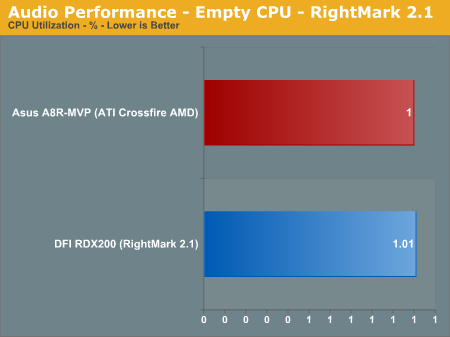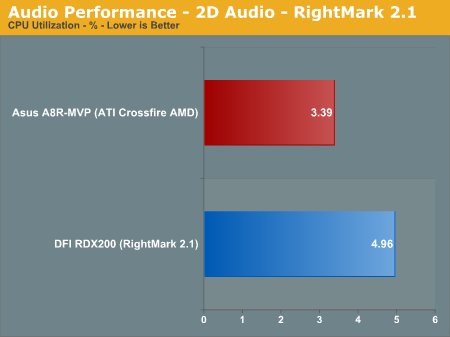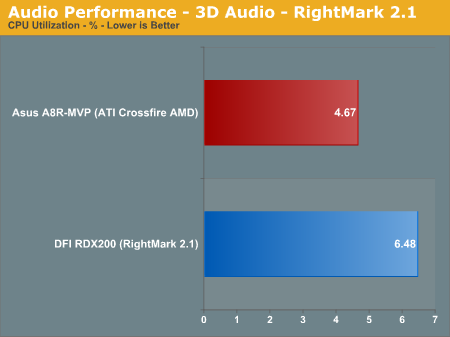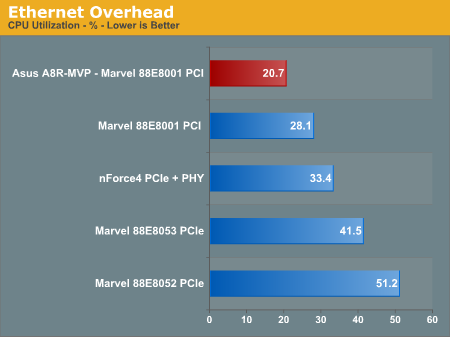Asus A8R-MVP: Mainstream Rocket
by Wesley Fink on November 23, 2005 1:15 AM EST- Posted in
- Motherboards
Audio Performance
For audio testing, we used Rightmark 3D Sound CPU utilization test, which is the same benchmark run in our earlier nForce4 SLI and Ultra roundups. This benchmark measures the overhead or CPU utilization required by a codec or hardware audio chip. We tested performance using the latest version 2.1. Since we found that Version 2.1 yields different results from the earlier 1.24, we have only included test results with version 2.1.
It is very important to point out that the ATI chipset motherboards have the necessary hooks to deliver Azalia High Definition audio. Those who have been complaining about the poor AC'97 audio present on most AMD boards should be very pleased to find Azalia HD on the ATI chipset boards. The nForce4 family does not offer the necessary chipset hooks to support HD Azalia audio.
Ethernet Performance
The one area where the Asus A8R-MVP is mildly disappointing is in their choice of an Ethernet controller. Instead of using a PCIe LAN that is capable of providing full 1 Gb bandwidth, Asus used a PCI solution that will be limited in maximum speed by the PCI bus. In practical terms, the PCI bus caps out about 700 Mb/s compared to the 950Mb/s capability of a 1 Gigabit PCIe solution. Since most broadband Ethernet connections barely tax 10Mb/s, this really only matters to those who do sustained high-speed transfer of very large files over a true 1Gb network - probably less than 1% of users. Still, you should be aware that PCIe Gigabit Ethernet is always a better solution.
The Windows 2000 Driver Development Kit (DDK) includes a useful LAN testing utility called NTttcp. We used the NTttcp tool to test Ethernet throughput and the CPU utilization of the various Ethernet Controllers used on the AMD motherboards.
We set up one machine as the server; in this case, an Intel box with an Intel CSA Gigabit LAN connection. Intel CSA has a reputation for providing fast throughput and this seemed to be a reasonable choice to serve our Gigabit LAN clients. At the server side, we used the following Command Line as suggested by the VIA whitepaper on LAN testing:
For audio testing, we used Rightmark 3D Sound CPU utilization test, which is the same benchmark run in our earlier nForce4 SLI and Ultra roundups. This benchmark measures the overhead or CPU utilization required by a codec or hardware audio chip. We tested performance using the latest version 2.1. Since we found that Version 2.1 yields different results from the earlier 1.24, we have only included test results with version 2.1.



It is very important to point out that the ATI chipset motherboards have the necessary hooks to deliver Azalia High Definition audio. Those who have been complaining about the poor AC'97 audio present on most AMD boards should be very pleased to find Azalia HD on the ATI chipset boards. The nForce4 family does not offer the necessary chipset hooks to support HD Azalia audio.
Ethernet Performance
The one area where the Asus A8R-MVP is mildly disappointing is in their choice of an Ethernet controller. Instead of using a PCIe LAN that is capable of providing full 1 Gb bandwidth, Asus used a PCI solution that will be limited in maximum speed by the PCI bus. In practical terms, the PCI bus caps out about 700 Mb/s compared to the 950Mb/s capability of a 1 Gigabit PCIe solution. Since most broadband Ethernet connections barely tax 10Mb/s, this really only matters to those who do sustained high-speed transfer of very large files over a true 1Gb network - probably less than 1% of users. Still, you should be aware that PCIe Gigabit Ethernet is always a better solution.
The Windows 2000 Driver Development Kit (DDK) includes a useful LAN testing utility called NTttcp. We used the NTttcp tool to test Ethernet throughput and the CPU utilization of the various Ethernet Controllers used on the AMD motherboards.
We set up one machine as the server; in this case, an Intel box with an Intel CSA Gigabit LAN connection. Intel CSA has a reputation for providing fast throughput and this seemed to be a reasonable choice to serve our Gigabit LAN clients. At the server side, we used the following Command Line as suggested by the VIA whitepaper on LAN testing:
Ntttcps -m 4,0,‹client IP› -a 4 -l 256000 -n 30000On the client side (the motherboard under test), we used the following Command Line:
Ntttcpr -m 4,0,‹server IP› -a 4 -l 256000 -n 30000At the conclusion of the test, we captured the throughput and CPU utilization figures from the client screen.












74 Comments
View All Comments
Avalon - Wednesday, November 23, 2005 - link
Wesley, just for giggles, can you set a RAM divider and drop your CPU multiplier down to 7x, and see how high the HTT can reach stably? That would be nice to see.n7 - Wednesday, November 23, 2005 - link
I may have just founds my next motherboard!As long as prices do come to the level of a mainstream mobo, this looks very good.
I have to admit, until the A8N32-SLI Deluxe, & now this, i was extremely unimpressed with all Asus A64 motherboards.
Now the last two i've seen from Asus look very good :)
fitten - Wednesday, November 23, 2005 - link
I see this a lot (particularly on AnandTech) and have yet to see any *real* benchmarks that show this change results in anything more than a 1% to 2% performance gain, which is typically within the statistical margin of error for the benchmarking performed by most review sites. Are there any definitive benchmarks (that are statistically significant) that show more of a gain than this?
Wesley Fink - Wednesday, November 23, 2005 - link
You have seen this a lot on AT and any site that specializes in performance and overclocking. Memtest86 is a standard test used in the memory industry to test performance. It shows a 5 to 10% increase in performance at 1T compared to 2T - depending on CPU speed and memory frequency. Similar increases are reported by SiSoft Sandra Unbuffered and Everest, which also measure memory bandwidth.Memory is only one small part of total performance, and in gaming 1T only increases framerate 1% to 5% depending on the game and equipment used for testing. You are correct that this won't be noticed by most end users, but if you are aiming for absolute top performance in gaming or competetive benchmarking this does matter. We covered this pretty thoroughly with test results in a memory piece several months ago.
Live - Wednesday, November 23, 2005 - link
Very nice review and a nice find!I would have loved to have seen the ASRock 939Dual-SATA2 included in the benchmarks. Why? It is just as close in price as many other boards and frankly cater to sort of the same user group. This would also show what can be had in the different price groups.
I also find this quote a bit strange
I would think that ASUS having low expectations on this board and they being genuinely surprised would indicate that there internal testing does not show the same results as your sample does. Thus indicating it is indeed an over performing sample. This possibility seems just as likely anyway. What I am missing?
Wesley Fink - Wednesday, November 23, 2005 - link
Asus does extensive overclocking tests on their top-line boards aimed at that market. They generally know how they will perform in overclocking. They do more modest tests on mainstream boards. It is my opinion it never occured to Asus that the A8R-MVP might be a monster overclocker until I reported my results back to them. Once I did, Asus was very helpful in adding additional options to BIOS that I suggested would be welcomed by overclockers. Some components limit what Asus can add, but they had added additional options that could be added.We do have a very good working relationship with Asus. As an example the first Asus A8N-SLI Premium boards (without the paddle) were supposed to be top-end. Our pre-production samples turned out to be very poor overclockers due to the automatic switches and Asus decided to rework the board rather than bring a mediocre board to market. The revised Premium came about 8 weeks later and we confirmed it was an oxcellent overclocker and a good performer. That is the board Asus brought to market.
Live - Wednesday, November 23, 2005 - link
Thanks for the clarification. I think I got what I was missing. In that light this board does look like a true gem in disguise.nvidia4ever - Wednesday, November 23, 2005 - link
Is there a reason why the X1800XT was not tested? By chance, did you test the board with a Opteron 148? I could see this combination being great together considering how well both overclock. That would be a killer package at $350. When will the board be available?Wesley Fink - Wednesday, November 23, 2005 - link
The motherboard lab does not a X1800XT for benchmarking, a fact we point out to ATI whenever we get the opportunity. ATI is still having X1800XT supply problems and they have promised we will have cards for testing as soon as they are available for sampling.We have to wonder aloud if we have had so much trouble getting X1800XT for testing, what chance does a "mere mortal" have to buy an X1800XT. We can only say we're glad ATI does not appear to have motherboard chipset supply issues, because the video card situation is horrendous.
nvidia4ever - Wednesday, November 23, 2005 - link
There are several x1800xt cards available here - http://www.newegg.com/Product/ProductList.asp?Manu...">x1800xt cards Is ATI just screwing around with you guys? Can this board run nvidia sli cards?